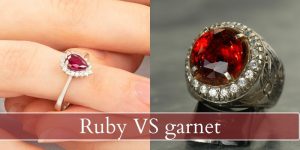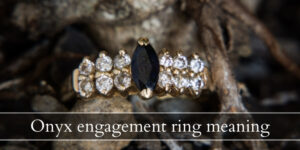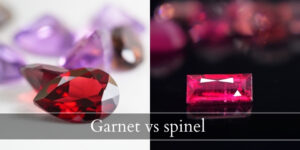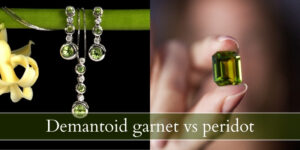Looking for a diamond that differs from the usual round cut brilliant ? How about an elongated rectangular diamond ? In this case you’ve got two very similar yet wildly different options, the radiant and the emerald cut. Both are long and can make most fingers appear longer and more elegant, but their overall look is quite different.
Today we’re comparing emerald cuts with radiant cuts so you can decide which would be a better fit for you. Of course, we recommend you walk into a jewelry show and try on both diamonds. No amount of reading up about them will compare to trying out the real deal. Still, it’s worth it to be prepared so read on.
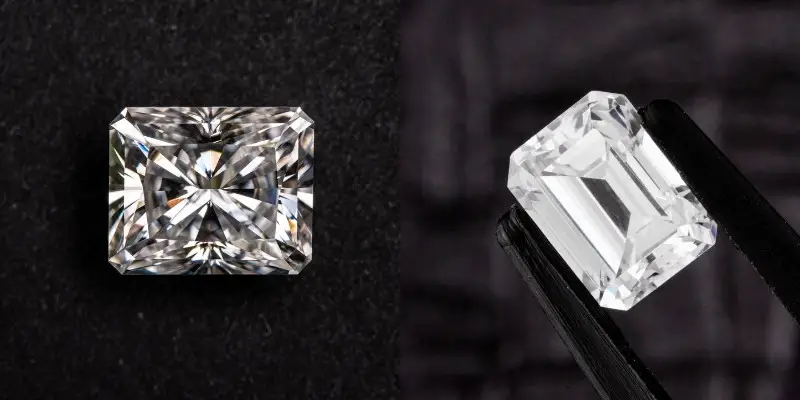
Radiant vs emerald cut
Radiants have far more brilliance and sparkle than an emerald cut, but may seem a trendy option while emerald cuts are a timeless, elegant diamond. Emerald cuts also show tint and inclusions much better so you have to get a very high grade diamond for an emerald cut, while a radiant is much more forgiving precisely due to its many brilliant facets on the pavilion. Also due to the facets on the pavilion a radiant cut may appear larger than an emerald cut of the same weight.
Overall the radiant cut offers more sparkle and is more forgiving towards a tinted or included diamond, while the emerald cut is a statement of elegance, high quality, and a pleasant deviation form the usual round brilliant.
What is emerald cut ?
The emerald cut is a rectangular diamond cut, with beveled corners for protection. The facets on an emerald cut are akin to a staircase, leading down into the diamond. Some also compare it to a hall of mirrors effect. This style of cutting a diamond is called step-cut, as opposed to the diamonds resembling crushed ice (brilliant cut).
The usual ratio on an emerald cut is 1:5 which makes a quite slender diamond. You can find them in less dramatic ratios, like 1.30:1 or even 1.20:1 but they are usually quite elongated.
This diamond cut style has very old roots, back in the centuries-old table cut, which then turned into a multifaceted table cut, and later into an emerald cut. Its final form was highly popular during the Art Deco era precisely because of its highly geometric look and clean, crisp lines.
It’s not as popular now, 100 years later, but it’s still one of the best known diamonds cut styles out there. Celebrities like Beyonce, Amal Clooney, Mariah Carey, J.Lo, and Elizabeth Taylor have sported emerald-cut diamonds.
Read also: Brilliant Cut VS Step Cut Diamonds
What is radiant cut ?
The radiant cut diamond is a direct inspiration from the emerald cut, but with a twist. The top (crown and table) resemble an emerald cut but with wide triangular facets instead of rectangular, while the pavilion has many, many brilliant facets, like the traditional round brilliant.
So the radiant cut offers an elongated look with the general shape of an emerald cut, but with the sparkle of a round brilliant (well, almost).
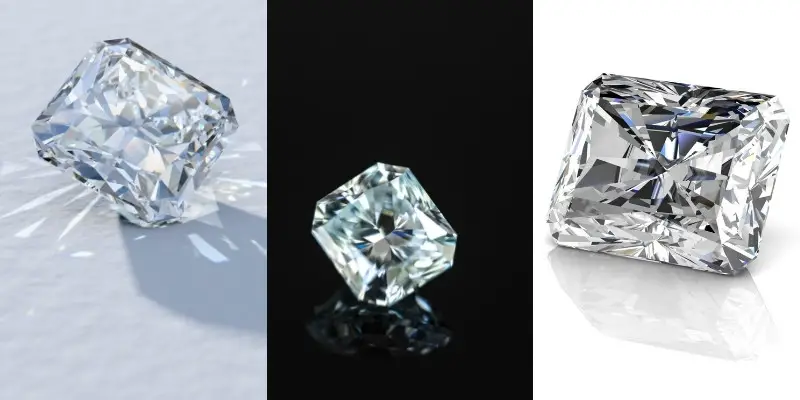
This is the work of Henry Grossbard, a master diamond cutter, who perfected the radiant cut in 1981. He wanted to improve on the emerald cut’s brilliance and fire, as he felt it was lacking. So he fiddled with various facets for the pavilion and the crown until he settled on the radiant we known today.
1. Radiant cut offers more brilliance than emerald cut
A key difference between emerald and radiant cuts is the brilliance a radiant cut offers. Its many, many facets on the pavilion offer a crushed-ice look, which in turn breaks the light into tiny shards and makes the diamond sparkle much more than an emerald cut ever could.
An emerald cut has long facets that offer less brilliance and more flashes of light. The only smaller facets on an emerald cut are neat the corners on the pavilion, in the shape of small triangles. So an emerald cut will still sparkle, but it will be much less than a radiant cut.
If you’re someone who likes their diamonds to be very sparkly, like a princess cut or a round brilliant, you might be better off with a radiant cut. If you’re someone who likes a more subdued look then perhaps the emerald cut would suit you better.
Do keep in mind that this is a significant point for many people when choosing their engagement ring diamond. This is a stone you will be wearing (hopefully) for many decades, so it should be something you truly like, not something bought on a whim.
2. Emerald cuts tend to show color better than radiant cuts
Because of the many inward-pointing facets of an emerald cut, any color tint in the diamond will be very visible. The color concentrates in an emerald cut, so if you’ve got a colored diamond you want to show off, this is a great option. So for example if you’ve got a fain pink diamond, its color will show up better and a bit more intense in an emerald cut than in a radiant cut.
This is also due to a radiant cut’s brilliance, which is mostly white light. It does reflect some rainbow colors, but much less than just white. So a colored diamond in a radiant cut will look bright and possibly a bit washed out (color-wise), due to the extra white light.
3. Radiants may appear larger than emerald cuts
Another point to take into consideration is how large the diamond appears on the finger. Of course, there is the ratio to consider. A 1.50:1 diamond will appear smaller than a same-carat diamond but with a 1.20:1 ratio. But, the longer diamond will usually make the finger look slimmer.
Radiants tend to have a smaller ratio than emerald cuts, and they also have all that brilliance going for them, which makes for a bigger-looking diamond than it actually is.
Some of the facets in an emerald cut appear lighter, some darker. And as they are so slim and parallel to each other, the overall effect can be one of a smaller diamond, as compared to a radiant.
So in short a 1 carat radiant will look bigger on the finger than a 1 carat emerald. In person the movement of the diamond will reveal its true size, but from afar and in photos, radiants will look a bit larger than emerald cuts.
4. Emerald cuts show diamond’s clarity, radiants are forgiving
One thing is for certain when you get an emerald cut diamond: it has to be nearly flawless in clarity. This diamond cut leaves no room for any noticeable inclusions, so you cannot compromise on clarity. This is a high-stakes kind of cut, so it will show any imperfections and any tint the diamond may have. Because of this you’ll find that emerald cut diamonds tend to be a bit more expensive than radiant cuts, simply because the good looking ones are of higher quality (color and clarity).
Radiants tend to mask imperfections and color tints, so you could easily get away with a VVS2 diamond with an H color and still have it look great. The same cannot be said for an emerald cut.
5. Radiant cuts are less popular than emerald cuts
In fashion trends always come and go, and all you’re left with is whether people remember a trend fondly or not. In the case of radiant cuts, they’re not exactly trendy but they are more of a late 2000s and onwards diamond in terms of popularity. Granted, the emerald cut is also a 1920-30 diamond but it’s quite timeless precisely due to its elegant, sleek lines.
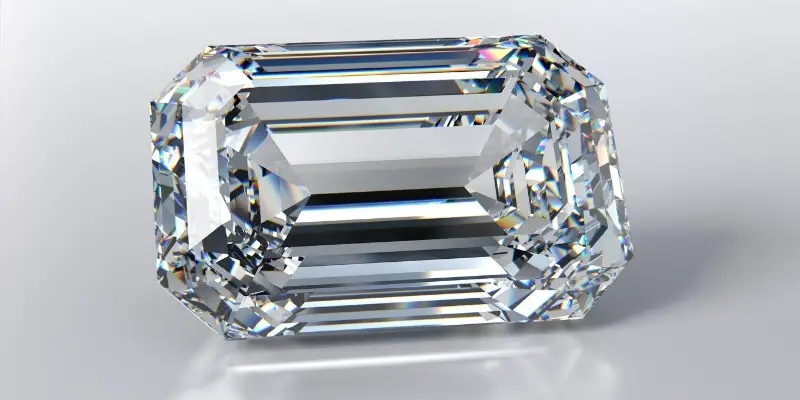
The issue we’ve seen is that people do stop to think twice whether their love for a radiant cut is because it’s currently ‘in’ or because they actually feel drawn to that diamond cut.
Even so, as they years have gone by, one conclusion is clear: emerald cuts tend to be more popular than radiants, simply for being more elegant and timeless.
This also means that you’ll have a harder time finding the exact radiant cut you like for your diamond, because there are simply less to choose from, as opposed to emerald cuts. In the end it’s always a good idea to go out and look at a radiant and an emerald cut of similar size and try them on. Nearly all stores will let you do this free of charge.

I’m the main author for jewelrymaterialguide.com. I started this site after we did tons of research before our wedding and noticed that there is information about rings, jewelry, and so on that is really hard to find on the internet.

